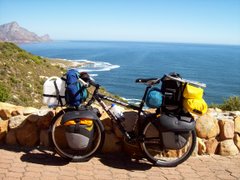
Since I've been in this country I've been asked by a number of curious Pakistani's why I'd decided to visit these warm regions at the height of summer. Of course, they first ask the other usual questions (Name? Country? Number of children? Religion? Married? - more or less in that sequence). Dropping down from the dry moderate highlands around Quetta to the plains of the Indus river and its tributaries, conditions became rather uncomfortable (upper 40's with humidity near saturation). From time to time my police escorts found it necessary to cool of in streams or canals along the way (photo). The escorts started soon after Quetta, and at times it was difficult for me to keep my bike out of their van, especially during the heat of the day when they weren't keen to follow me around at cycling pace. Fortunately I managed to stay on the road for most of the distance between overnight points each day. I was compelled to proceed to the next large town or city where there was a hotel, and on a number of occasions I was prevented from leaving the hotel in the evening by an armed guard posted there for "my own safety". The morning when I left for Lahore I didn't notice my escorts anywhere so I made a break for it, and have been enjoying a wonderful few days of freedom. I've stayed in the cheapest hotels (3 to 7 U$), where it doesn't matter if the rats are playing "hop-scotch" in the room or that there may be an impressive collection of mouldy mango pips in the bedside cupboard. What really matters is that there must be a large and powerful ceiling fan in the room. Unfortunately the frequent electricity cuts are a problem, and I've spent more than one night sleeping on the roof of hotels amongst the locals (even they don't dare return to their "sauna" before the fan starts spinning again!). The power failures also make it very frustrating to do anything on the internet - this is my 5th attempt in the past 2 days to publish this post - so please forgive me if I haven't replied to your e-mails. The streets of the villages in the areas I've cycled through have been chaotic, with obstacles coming from all directions (trucks, busses, taxis, tractors, tuk-tuks, motorbikes, bicycles, ox-carts, camel-carts, buffalo-carts, horse-carts, donkey-carts, hawker-trolleys, careless pedestrians, and an assortment of wandering animals). The local driving is rather suspect, and even the police escort van bumped me into a donkey cart one day. A few days ago I had a more serious fall, and have decided to spend a few recovery days in Lahore, where I am now. This time I selected a room which not only has a fan, but also a TV (so I can watch the current SA vs Eng cricket test). I also have a "wonderful" view from the room over the city (photo). Pakistan is a cricket-crazy country, and the moment I mention that I'm from South Africa I become an instant celebrity. For a while I was also a bit of a celebrity after appearing on the TV news about a week ago, but that fame seems to be wearing off now. From Lahore I plan to cycle on towards Islamabad, where I will probably meet up with Leana when she returns from her mountain trekking next week. Distances cycled since Quetta were:- Sibi 92 km; Sukkur 139 km; Rahim Yar Khan 101 km; Bahawalpur 103 km; Multan 55 km; Khanewal 59 km; Sahiwal 140 km; Pattoki 82 km; Lahore 99 km.







































